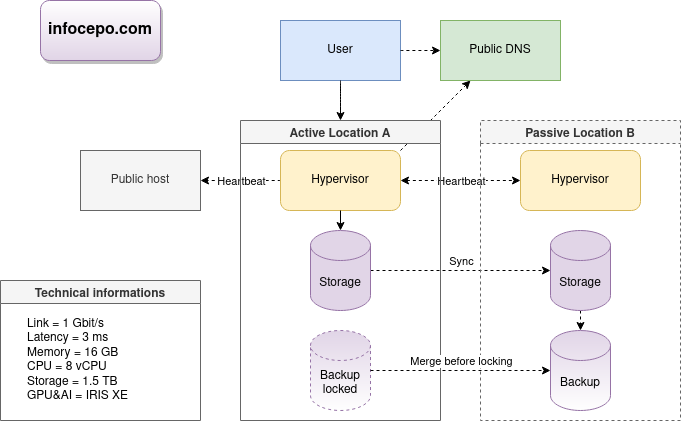Main Page
Welcome to my experimental WIKI.
Resume of this page with OPENAI :" I provide here a list of topics related to cloud computing and information technology. Some of the topics mentioned include cloud lab, infra audit, cloud migration, cloud improvement, cloud providers, cloud mapping, infrastructure examples, IT salaries, and high availability using Corosync and Pacemaker.
I'm discussing various tools and technologies that can be used in cloud computing, such as Kubernetes, OpenStack, AWS, and Open Virtualization (OVIRT). I also mention the importance of using open source software and minimizing technology lock-in.
I'm discussing the process of migrating to the cloud, including the steps involved in preparing for the migration, as well as the tools and technologies that can be used to automate the process. I also mention the importance of considering the cost and benefits of different cloud providers and the need to carefully evaluate the trade-offs between different options.
Overall, I'm discussing the various factors that need to be considered when designing and implementing a cloud computing infrastructure. I hope this information is helpful! If you have any specific questions about any of the topics mentioned, please don't hesitate to ask."
AI tools
CLOUD LAB
I want to share my LAB project.

INFRA audit
I made ServerDiff.sh script to audit servers. You can track configuration drift. You can check if your environments are the same.
CLOUD migration example
- 1.5 days: infra audit (82 clustered services) (audit own tool)
- 1.5 days: physical and virtual target CLOUD architecture diagram
- 1.5 days: physical compliance of 2 CLOUD (6 hypervisors, 6TB memory)
- 1 days: installation of the 2 CLOUD
- .5 day: stability check
| ACTION | RESULT | OK/KO |
| Activate maintenance for n/2-1 nodes or 1 node if 2 nodes. | All resources are started. | |
| Un-maintenance all nodes. Power off n/2-1 nodes or 1 node if 2 nodes, different from the previous test. | All resources are started. | |
| Power off simultaneous all nodes. Power on simultaneous all nodes. | All resources are started. |
- 1.5 days: CLOUD automation study
- 1.5 days: 6 templates (2 CLOUD, 2 OS, 8 environments, 2 versions)
- 1 day: migration diagram
- 1.5 days: 138 lines of industrialization code for migration (migration own code)
- 1.5 days: process stabilization
- 1.5 days: CLOUD benchmark vs old INFRA
- .5 days: calibration of unavailability time per unit migration
- 5 minutes (effective load): 82 VM (env, os, application_code, 2 IP)
Total = 15 man-days
CLOUD improvement
- Formalize your infrastructure as much as possible for more flexibility, low complexity and less technology lock-in.
- Use a name server able to handle the position of your customers like GDNS.
- Use a minimal instance and use a network load balancer like LVS. Monitor the global load of your instances and add/delete dynamically as needed.
- Or, many providers have dynamic computing services. Compare the prices. But take care about the technology lock-in.
- Use a very efficient TLS decoder for the frontend like the HAPROXY decoder.
- Use very fast http cache like VARNISH.
- Use a big cache for big files like Apache Traffic Server.
- ...
- Use a REVERSE PROXY with TLS decoder like ENVOY for more services compatibility.
- Use serverless service for standard runtimes like Java, Python and PHP. But beware of certain incompatibilities and a lack of consistency over time.
- ...
- Each time you need dynamic computing power think about load balancing or native service from the providers (caution about providers services!)
- ...
- Try to use open source STACKs as much as possible.
- ...
- Use cache for your databases like MEMCACHED
CLOUD vs HW
| Function | KUBERNETES | OPENSTACK | AWS | Bare-metal | HPC | CRM | OVIRT |
| DEPLOY | HELM/ANSIBLE/SH | TERRAFORM/ANSIBLE/SH/JUJU | TERRAFORM/CLOUDFOUNDATION/ANSIBLE/JUJU | ANSIBLE/SH | XCAT/CLUSH | ANSIBLE/SH | ANSIBLE/PYTHON/SH |
| BOOTSTRAP | API/CLI | PXE/API/CLI | API/CLI | PXE/IPMI | PXE/IPMI | PXE/IPMI | PXE/API |
| Router | API/CLI (kube-router) | API/CLI (router/subnet) | API/CLI (Route table/subnet) | LINUX/OVS/external | XCAT/external | LINUX/external | API |
| Firewall | INGRESS/EGRESS/ISTIO | API/CLI (Security groups) | API/CLI (Security group) | LINUX (NFT) | LINUX (NFT) | LINUX (NFT) | API |
| Vlan/Vxlan | many | API/CLI (VPC) | API/CLI (VPC) | OVS/LINUX/external | XCAT/external | LINUX/external | API |
| Name server | coredns | dns-nameserver | Amazon Route 53 | GDNS | XCAT | LINUX/external | API/external |
| Load balancer | kube-proxy/LVS(IPVS) | LVS | Network Load Balancer | LVS | SLURM | Ldirectord | |
| Storage | many | SWIFT/CINDER/NOVA | S3/EFS/FSX/EBS | OPENSTACK SWIFT/XFS/EXT4/RAID10 | GPFS | SAN | NFS/SAN |
CLOUD REF
CLOUD providers
CLOUD map
Infrastructure example
IT salaries
REDHAT package browser
HA COROSYNC+PACEMAKER
Typical architecture
- 2 rooms
- 2 power supply
- 2FC / server (active/active) (SAN)
- 2*10Gbit/s ethernet / server (active/passive, possible active/active if PXE on native VLAN 0)
- IPMI VLAN (for the fence)
- VLAN ADMIN which must be the native VLAN if BOOTSTRAP by PXE (admin, provisioning, heartbeat)
- USER VLAN (application services)
- NTP
- DNS+DHCP+PXE+TFTP+HTTP for auto-provisioning
- PROXY (for update or otherwise internal REPOSITORY)
- Choose between 2 or more node clusters.
- For a 2-node architecture, you need a 2-node configuration on COROSYNC and make sure to configure a 10-second staggered closing for one of the nodes (otherwise, an unstable cluster results).
- Resources are stateless.
For DB resources it is necessary to provide 4GB per base in general. For CPU resources, as a rule there are no big requirements. Tip, for time-critical compressions, use PZSTD.
Typical service pattern
- MULTIPATH
- LUN
- LVM (LVM resource)
- FS (FS resource)
- NFS (FS resource)
- USER
- IP (IP resource)
- DNS name
- PROCESS (PROCESS resource)
- LISTENER (LISTENER resource)

